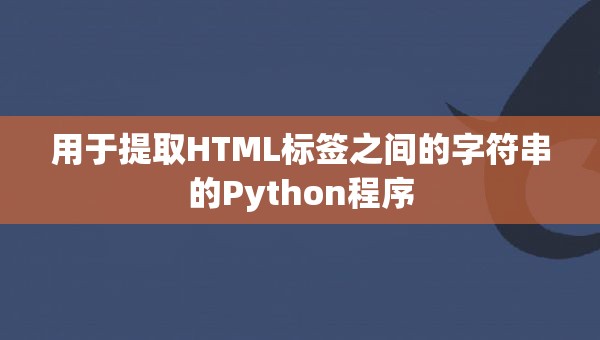- 12022 年全国职业院校技能大赛高职组云计算赛项试卷部分解析
- 2Python IDE Pycharm服务器配置方法并结合内网穿透工具实现远程开发
- 3Unity游戏在安卓11 手机上闪退问题记录_unity 手机调试切换场景闪退
- 4架构的演变_架构演变
- 5再深入一点|binlog和relay-log到底长啥样?_binlog长啥样
- 6基于STM32的开源简易示波器项目_基于stm32的示波器
- 7学生管理系统--添加、查看功能_学生管理系统无法实现个人页面跳转
- 8python中的yield关键字是个什么鬼?它有什么用处?_yield关键字的作用
- 9uniapp Android调用各种权限(主要解决webview使用相机无法获取权限)_ue android配置开启相机权限
- 10Microsoft Word 设置底纹
用于提取HTML标签之间的字符串的Python程序_python截取html页面中两个tag中的内容
赞
踩

HTML 标记用于设计网站的骨架。我们以标签内包含的字符串的形式传递信息和上传内容。HTML 标记之间的字符串决定了浏览器将如何显示和解释元素。因此,这些字符串的提取在数据操作和处理中起着至关重要的作用。我们可以分析和理解HTML文档的结构。
这些字符串揭示了网页构建背后的隐藏模式和逻辑。在本文中,我们将处理这些字符串。我们的任务是提取 HTML 标记之间的字符串。
了解问题
我们必须提取 HTML 标签之间的所有字符串。我们的目标字符串包含在不同类型的标签中,只应检索内容部分。让我们借助一个例子来理解这一点。
输入输出方案
让我们考虑一个字符串 -
Input: Inp_STR = "<h1>This is a test string,</h1><p>Let's code together</p>"
输入字符串由不同的 HTML 标签组成,我们必须提取它们之间的字符串。
Output: [" This is a test string, Let's code together "]
如我们所见,“<h1>”和“<p>”标签被删除并提取字符串。现在我们已经了解了问题,让我们讨论一些解决方案。
使用迭代和替换()
此方法侧重于消除和替换 HTML 标记。我们将传递一个字符串和一个不同 HTML 标签的列表。在此之后,我们将初始化此字符串作为列表的元素。
我们将遍历标签列表中的每个元素,并检查它是否存在于原始字符串中。我们将传递一个“pos”变量,该变量将存储索引值并驱动迭代过程。
我们将使用 “replace()” 方法将每个标签替换为空白区域,并检索一个 HTML 标签自由字符串。
例
下面是一个在 HTML 标记之间提取字符串的示例 -
Inp_STR = "<h1>This is a test string,</h1><p>Let's code together</p>" tags = ["<h1>", "</h1>", "<p>", "</p>", "<b>", "</b>", "<br>"] print(f"This is the original string: {Inp_STR}") ExStr = [Inp_STR] pos = 0 for tag in tags: if tag in ExStr[pos]: ExStr[pos] = ExStr[pos].replace(tag, " ") pos += 1 print(f"The extracted string is : {ExStr}")
输出
This is the original string: <h1>This is a test string,</h1><p>Let's code together</p> The extracted string is : [" This is a test string, Let's code together "]
使用 Regex Module + findall()
在这种方法中,我们将使用正则表达式模块来匹配特定模式。我们将传递一个正则表达式:“<”+标签+“>(.*?)</“+标记+”>“,表示目标模式。此模式旨在捕获开始和结束标记。在这里,“tag”是一个变量,它借助迭代从标签列表中获取其值。
“findall()” 函数用于查找原始字符串中模式的所有匹配项。我们将使用 “extend()” 方法将所有 “matches” 添加到新列表中。通过这种方式,我们将提取包含在 HTML 标签中的字符串。
例
下面是一个示例 -
import re Inp_STR = "<h1>This is a test string,</h1><p>Let's code together</p>" tags = ["h1", "p", "b", "br"] print(f"This is the original string: {Inp_STR}") ExStr = [] for tag in tags: seq = "<"+tag+">(.*?)</"+tag+">" matches = re.findall(seq, Inp_STR) ExStr.extend(matches) print(f"The extracted string is: {ExStr}")
输出
This is the original string: <h1>This is a test string,</h1><p>Let's code together</p> The extracted string is: ['This is a test string,', "Let's code together"]
使用 Iteration 和 find()
在这种方法中,我们将借助 “find()” 方法获得原始字符串中开始和结束标签的第一次出现。我们将遍历标签列表中的每个元素并检索其在字符串中的位置。
While 循环将用于继续搜索字符串中的 HTML 标记。我们将建立一个条件来检查字符串中是否存在不完整的标签。在每次迭代中,索引值都会更新,以查找开始标记和结束标记的下一个匹配项。
存储所有开始和结束标记的索引值,一旦映射了整个字符串,我们就使用字符串切片来提取 HTML 标记之间的字符串。
例
下面是一个示例 -
Inp_STR = "<h1>This is a test string,</h1><p>Let's code together</p>" tags = ["h1", "p", "b", "br"] ExStr = [] print(f"The original string is: {Inp_STR}") for tag in tags: tagpos1 = Inp_STR.find("<"+tag+">") while tagpos1 != -1: tagpos2 = Inp_STR.find("</"+tag+">", tagpos1) if tagpos2 == -1: break ExStr.append(Inp_STR[tagpos1 + len(tag)+2: tagpos2]) tagpos1 = Inp_STR.find("<"+tag+">", tagpos2) print(f"The extracted string is: {ExStr}")
输出
The original string is: <h1>This is a test string,</h1><p>Let's code together</p> The extracted string is: ['This is a test string,', "Let's code together"]
结论
在本文中,我们讨论了在 HTML 标记之间提取字符串的多种方法。我们从更简单的解决方案开始,用空格定位和替换标签。我们还使用 regex 模块及其 findall() 函数来查找与模式的匹配项。我们了解了find()方法的应用以及字符串切片。


